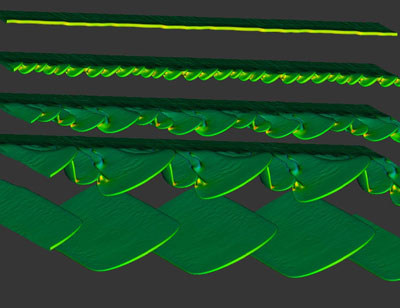| Posted: March 29, 2010 |
Model predicts and describes how materials break |
|
(Nanowerk News) For the first time ever, a study of this new mathematical model published in Nature has managed to describe the fracture process for materials such as glass, polymers, concrete, ceramics, metals, rocks, and even certain geological fractures.
|
|
Antonio J. Pons, of the research group on Nonlinear Dynamics, Nonlinear Optics and Lasers of the Universitat Politècnica de Catalunya (UPC)-Barcelona Tech at the Terrassa Campus, has developed a new mathematical model leading to a new law of physics that describes all the stages involved in the way materials crack, making it possible to predict how they will do so before the fracture actually occurs. This is the first time ever that this model has been used to describe objects or materials in 3D, namely all of those that occupy a volume in space and are isotropic, with a homogeneous structure. The study, published in the first week of March in Nature, has been completed in collaboration with researcher Alain Karma, professor at Northeastern University in Boston.
|
 |
| Computer model of a crack. This is the first time ever that this model has been used to describe objects and materials in 3D.
|
|
A powerful simulation
|
|
From a technological, physical, and geological perspective, everything around us is material, and everything is potentially breakable: the wing of an airplane, the column supporting a building, the hull of a ship, the nozzle of a hose and even the structure of the Earth in a geological fault. Until now, science strove to understand how the simplest things broke: two-dimensional objects such as sheets of paper, for instance; meanwhile, breakage in three-dimensional objects continued to baffle scientists.
|
|
It is known that if certain tensions are applied to objects, they crack, but what remains uncertain is what forces describe the crack path and how it occurs. Antonio J. Pons' study puts an end to this uncertainty, creating a simulation model powerful enough to predict and describe crack patterns in structures ranging in size from the microscopic to others as large as certain geological faults. This simulation model actually replicates all the stages in the fracture process from beginning to end, and knowing how certain materials behave can enable us to design new materials that are far more crack-resistant.
|
|
How some materials break
|
|
A material-or, in other words, any solid object or element in our environment-can break in three different ways: from top to bottom (as in the San Andreas Fault, in California); horizontally, like a cut; or as a tear, for instance when a cable is pulled and twisted at the same time.
|
|
To set a few other examples, the fault along the Serranía del Interior mountain range in Venezuela cracks following a mixed pattern, combining the first and the third model; the crankshaft in a car motor breaks from torsion and fatigue; an adjustable wrench also breaks from fatigue; polymer materials crack like rocks; objects made of glass break along the same crack lines as geological fractures.
|
|
Disaster prediction
|
|
Antonio J. Pons' new method now enables the scientific community to describe the processes involved in the fracture of materials from their initial state, as the break develops, and its final outcome at all scales. In addition, the method allows for describing cracks mathematically in three dimensions. The method also enables us to perform numerical simulations that were impossible until now. With this research, crack front patterns can be predicted before they appear, opening up the possibility of applications for preventing disasters and optimizing materials or new production techniques for microscopic elements. It also enables us to predict and gain a better understanding of the way in which bones break in patients suffering from certain pathologies such as osteoporosis.
|
|
Macro and micro technological applications
|
|
"Our method offers enormous potential because it enables us to study and understand natural problems that have technological implications", Pons explains. The UPC-Barcelona Tech researcher's study can prove highly useful in the field of materials technology, for instance: if the model is capable of reproducing cracks at the microscopic level, it can also be instrumental in providing an understanding of how to control them, thus opening up the possibility of using the resulting structures as microscopic molds. However, this would occur in a later stage of the research.
|
|
Another useful application of this mathematical model involves understanding the behavior of large structures such as buildings in areas with intense seismic activity. The new method makes it possible to modify construction materials to make these buildings safer.
|

